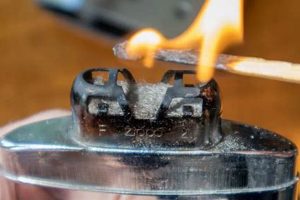Catalytic heaters utilize lighter fluid as fuel to generate warmth. These portable devices, often employed for outdoor activities or in emergencies, contain a platinum catalyst that facilitates the oxidation of the fuel without producing a flame. This catalytic reaction releases heat, providing a consistent source of warmth for extended periods.
Compact and lightweight, these pocket-sized heating solutions offer a reliable warmth source independent of external power. Their history traces back to early 20th-century advancements in catalytic technology, eventually leading to their widespread adoption for personal warming. Their portability and self-contained nature make them particularly valuable in situations where other heating methods are unavailable or impractical. These characteristics make them a preferred choice for individuals engaging in outdoor pursuits such as hunting, fishing, or camping, as well as for emergency preparedness.
This exploration will delve further into the safe handling and operation of catalytic heaters, proper fuel selection, maintenance procedures, and available alternatives for portable warmth generation.
Safety and Usage Tips for Catalytic Heaters
Safe and effective use of catalytic heaters requires adherence to specific guidelines. These precautions ensure optimal performance and mitigate potential hazards.
Tip 1: Employ Only Appropriate Fuel: Utilize only refined lighter fluid specifically designed for catalytic heaters. Avoid gasoline, kerosene, or other flammable liquids, as these can damage the catalyst and pose significant safety risks.
Tip 2: Adhere to Filling Instructions: Carefully follow the manufacturer’s instructions for filling the heater. Overfilling can lead to fuel spillage and fire hazards. Ensure the filling process occurs in a well-ventilated area away from ignition sources.
Tip 3: Allow for Proper Catalyst Activation: After filling, allow sufficient time for the catalyst to become saturated with fuel before igniting. Premature ignition can result in incomplete combustion and reduced heat output.
Tip 4: Exercise Caution with Hot Surfaces: The catalytic heater’s surface becomes hot during operation. Avoid direct contact with skin to prevent burns. Utilize the provided protective cover or case when handling.
Tip 5: Ensure Adequate Ventilation: While catalytic heaters produce minimal carbon monoxide, using them in confined spaces without proper ventilation is discouraged. Maintain adequate airflow to prevent the buildup of potentially harmful gases.
Tip 6: Extinguish the Heater Completely Before Refilling: Allow the heater to cool down completely before attempting to refill it. Introducing fuel to a hot catalyst can create a fire hazard.
Tip 7: Store Fuel Safely: Store lighter fluid in a cool, dry place away from children and ignition sources. Avoid storing the heater with fuel inside for extended periods.
Adhering to these safety precautions ensures the safe and efficient operation of catalytic heaters, providing a reliable source of warmth in various situations. Responsible usage maximizes the lifespan of the device and minimizes potential risks.
By understanding and following these guidelines, users can confidently utilize catalytic heaters while prioritizing safety and maximizing their effectiveness. This knowledge allows for informed decisions regarding portable warmth solutions.
1. Fuel Type
Fuel type plays a critical role in the safe and effective operation of catalytic hand warmers. Selecting the appropriate fuel is paramount for maintaining the device’s integrity and ensuring user safety. Using the incorrect fuel can lead to malfunction, reduced performance, and potentially hazardous situations.
- Refined Lighter Fluid
Specifically designed for catalytic heaters, refined lighter fluid provides clean, efficient combustion. This specialized fuel formulation minimizes clogging of the catalyst and ensures optimal heat output. Examples include Ronsonol and Zippo lighter fluids. Using refined lighter fluid is crucial for maintaining the longevity of the hand warmer and preventing damage.
- Inappropriate Fuels (Gasoline, Kerosene, etc.)
Fuels such as gasoline, kerosene, and other flammable liquids are unsuitable for catalytic hand warmers. These fuels can produce excessive heat, damage the catalyst, and pose a significant fire hazard. Their chemical composition is incompatible with the catalytic process, leading to incomplete combustion and the potential release of harmful byproducts. Never use these fuels in a catalytic hand warmer.
- Impact on Catalyst Lifespan
Using the correct fuel directly impacts the lifespan of the platinum catalyst. Refined lighter fluid preserves the catalyst’s integrity, allowing for consistent performance over extended periods. Conversely, using inappropriate fuels can permanently damage the catalyst, rendering the hand warmer unusable. Proper fuel selection is essential for maximizing the device’s lifespan.
- Safety Implications of Fuel Choice
Fuel choice has direct safety implications. Using the correct fuel minimizes the risk of fire and ensures efficient, controlled combustion. Conversely, using inappropriate fuels can create dangerous conditions, including uncontrolled flames and the release of harmful fumes. Prioritizing the use of refined lighter fluid is paramount for safe operation.
In summary, the choice of fuel is inextricably linked to the performance and safety of catalytic hand warmers. Using refined lighter fluid is essential for ensuring proper function, maximizing lifespan, and mitigating potential hazards. Understanding the distinctions between appropriate and inappropriate fuels is fundamental for responsible and safe operation.
2. Filling Procedure
The filling procedure for catalytic hand warmers using lighter fluid is crucial for safe and efficient operation. Correct execution prevents fuel spillage, optimizes heat output, and mitigates potential hazards. The procedure involves specific steps designed to ensure the precise amount of fuel reaches the catalyst without overflowing or causing leaks.
Typically, the process begins by ensuring the hand warmer is extinguished and cool. The filler cap is then carefully removed, and the hand warmer is held at a slight angle to prevent airlocks. Using the appropriate filling device, typically provided with the hand warmer, the correct amount of refined lighter fluid is slowly dispensed into the filling chamber. Overfilling should be avoided as it can lead to fuel leakage and fire hazards. Once filled, the cap is securely replaced, ensuring a proper seal to prevent fuel evaporation. The hand warmer is then allowed to sit upright for a few minutes to allow the fuel to saturate the catalyst before ignition.
For instance, if the hand warmer is overfilled, excess fuel may leak during operation, creating a fire risk when exposed to the catalyst’s heat. Conversely, underfilling may result in insufficient heat output, rendering the hand warmer ineffective. Furthermore, using an improper filling device can damage the filling mechanism and compromise the hand warmer’s integrity. Careful adherence to the manufacturer’s instructions ensures optimal performance and minimizes potential risks.
Precise execution of the filling procedure is essential for safe and effective use. It directly impacts the hand warmer’s performance, longevity, and user safety. Understanding and following the correct procedure allows users to maximize the benefits of this portable heating solution while minimizing potential hazards. This knowledge empowers informed decision-making and promotes responsible use of catalytic hand warmers.
3. Catalyst Activation
Catalyst activation represents a crucial stage in the operation of catalytic hand warmers fueled by lighter fluid. This process involves the saturation of the platinum catalyst with fuel vapor, enabling the exothermic reaction that produces heat. Without proper catalyst activation, the hand warmer will not function correctly. The lighter fluid, typically refined naphtha, plays a direct role in this activation process. Upon filling the hand warmer, the fluid begins to evaporate, and the resulting vapor permeates the catalyst material. This saturation process allows the platinum catalyst to facilitate the oxidation of the fuel vapor, releasing heat without producing a flame. The efficiency and duration of the hand warmer’s heating capacity are directly linked to the successful activation of the catalyst.
For example, if the catalyst is not adequately saturated with fuel vapor, the reaction may be incomplete, resulting in reduced heat output or a shorter heating duration. Prematurely attempting to ignite the hand warmer before the catalyst is fully activated can lead to inefficient burning and potential fuel waste. Conversely, a fully saturated catalyst ensures optimal heat generation and extends the hand warmer’s operational lifespan. The time required for complete catalyst activation varies depending on the specific model and ambient temperature, but typically ranges from a few minutes to several minutes. Understanding this activation process is essential for maximizing the hand warmer’s effectiveness and ensuring user satisfaction.
In summary, catalyst activation is inextricably linked to the successful operation of a catalytic hand warmer utilizing lighter fluid. The saturation of the platinum catalyst with fuel vapor is essential for initiating the exothermic reaction that generates heat. Proper execution of the filling and activation procedures ensures efficient fuel consumption and maximizes the hand warmer’s heating potential. This understanding is crucial for achieving reliable performance and maximizing the utility of this portable heating solution.
4. Safety Precautions
Safe handling of catalytic hand warmers utilizing lighter fluid requires careful attention to specific safety precautions. These precautions are essential for mitigating potential hazards associated with the fuel and the heated device. Neglecting these safety measures can lead to burns, fire hazards, or other undesirable outcomes. Understanding and adhering to these precautions ensures safe and effective utilization of this heat source.
- Handling Fuel Safely
Lighter fluid, the fuel source for these hand warmers, is highly flammable. Store and handle the fluid in a well-ventilated area away from open flames and ignition sources. Avoid inhaling fumes, and ensure proper ventilation during the filling process. Spilled fuel should be cleaned immediately to prevent accidental ignition. For example, storing lighter fluid near a lit cigarette poses a significant fire risk. Furthermore, using the hand warmer in an enclosed space with insufficient ventilation can lead to a buildup of flammable fumes.
- Managing the Heated Surface
Catalytic hand warmers produce significant heat, and direct contact with the device’s surface can cause burns. Use the provided protective pouch or handle the warmer carefully to avoid skin contact. Allow the device to cool completely before refilling or storing. Placing a hot hand warmer directly against skin or flammable materials can cause burns or ignite a fire. Using the protective pouch provided with the device mitigates this risk.
- Preventing Carbon Monoxide Exposure
While catalytic hand warmers produce minimal carbon monoxide compared to open flames, some carbon monoxide is still generated. Ensure adequate ventilation when using the device, especially in enclosed spaces. Never use the hand warmer in a completely sealed environment, such as a tent or sleeping bag, without sufficient airflow. Prolonged exposure to even low levels of carbon monoxide can lead to health issues. Using the hand warmer in a well-ventilated area mitigates this risk.
- Proper Storage and Maintenance
Store the hand warmer, when not in use and completely cooled, in a safe location away from children and pets. Regularly inspect the device for damage or leaks. Do not attempt to disassemble or repair the hand warmer yourself; consult the manufacturer’s instructions or contact customer support for assistance. A damaged hand warmer can pose a safety risk and should not be used until repaired or replaced. Storing the device safely prevents accidental activation or access by children.
These safety precautions are integral to the safe and effective use of catalytic hand warmers fueled by lighter fluid. Adhering to these guidelines minimizes potential risks and ensures the proper functionality of the device, providing a safe and reliable source of warmth in various situations. Ignoring these precautions can lead to accidents and negate the benefits of this otherwise useful tool.
5. Ventilation
Ventilation plays a crucial role in the safe operation of catalytic hand warmers utilizing lighter fluid. The catalytic combustion process, while flameless, consumes oxygen and produces byproducts, including small amounts of carbon monoxide. Adequate ventilation is essential to prevent the buildup of these byproducts, particularly carbon monoxide, to levels that could pose health risks. Insufficient ventilation can lead to a dangerous accumulation of carbon monoxide, especially in confined spaces. For example, using a catalytic hand warmer inside a small, unventilated tent or vehicle could create a hazardous environment due to restricted airflow and the resulting concentration of carbon monoxide.
The importance of ventilation stems from the potential health risks associated with carbon monoxide exposure. Carbon monoxide is a colorless, odorless gas that can cause headaches, dizziness, nausea, and even death in high concentrations. Even low levels of carbon monoxide can have adverse health effects over prolonged exposure. Therefore, ensuring adequate ventilation when using a catalytic hand warmer is paramount for user safety. Opening windows, using the hand warmer in larger spaces, or avoiding use in entirely enclosed areas are practical steps to maintain safe levels of ventilation. For instance, using a catalytic hand warmer while sitting on an open porch provides sufficient airflow to disperse any byproducts, whereas using it inside a sealed sleeping bag creates a potentially dangerous scenario.
In summary, the connection between ventilation and catalytic hand warmers using lighter fluid centers on mitigating the risks associated with carbon monoxide production. Adequate ventilation ensures the safe dispersal of combustion byproducts and prevents their accumulation to hazardous levels. Understanding this connection and taking appropriate precautions, such as using the hand warmer in well-ventilated areas, are essential for ensuring user safety and maximizing the benefits of this portable heating solution. Neglecting proper ventilation can have serious health consequences and underscores the importance of this critical safety aspect.
Frequently Asked Questions
This section addresses common inquiries regarding the use of lighter fluid in catalytic hand warmers, aiming to provide clear and concise information for safe and effective operation.
Question 1: What type of lighter fluid is recommended for catalytic hand warmers?
Only refined lighter fluid, specifically designed for catalytic heaters, should be used. Avoid using gasoline, kerosene, or other flammable liquids, as these can damage the catalyst and create safety hazards.
Question 2: How does one fill a catalytic hand warmer safely?
Ensure the hand warmer is cool and extinguished before filling. Carefully remove the filler cap and slowly dispense the recommended amount of refined lighter fluid using the appropriate filling device. Avoid overfilling. Securely replace the cap after filling.
Question 3: How long does it take for the catalyst to activate?
Catalyst activation time varies depending on the specific hand warmer model and ambient temperature, typically ranging from a few minutes to several minutes. Allow sufficient time for the catalyst to saturate with fuel vapor before igniting.
Question 4: What safety precautions should be observed when using a catalytic hand warmer?
Handle lighter fluid carefully in a well-ventilated area away from ignition sources. Avoid direct skin contact with the heated surface. Ensure adequate ventilation during use, especially in enclosed spaces. Store the device safely when not in use.
Question 5: Why is ventilation important when using a catalytic hand warmer?
Ventilation is crucial for dispersing combustion byproducts, including small amounts of carbon monoxide. Adequate airflow prevents the buildup of these gases to potentially hazardous levels, ensuring user safety.
Question 6: What should be done if lighter fluid spills during the filling process?
Immediately clean any spilled lighter fluid using an absorbent material. Ensure the area is well-ventilated and free of ignition sources before resuming the filling process or using the hand warmer.
Adherence to these guidelines and a thorough understanding of safe handling procedures are essential for the effective and safe use of catalytic hand warmers.
For further information and specific instructions, consult the manufacturer’s documentation provided with the hand warmer.
Conclusion
Catalytic heaters fueled by lighter fluid offer a portable and effective means of generating warmth in various contexts. Safe and efficient utilization requires a thorough understanding of fuel selection, filling procedures, catalyst activation, and associated safety precautions. Proper ventilation is paramount given the production of combustion byproducts, including carbon monoxide. Adherence to manufacturer guidelines and informed operational practices are essential for maximizing the benefits while mitigating potential hazards.
Portable heating solutions play a significant role in outdoor activities and emergency preparedness. Continued advancements in catalytic technology promise further improvements in efficiency and safety. Responsible usage, coupled with ongoing innovation, ensures the enduring utility of these devices for personal warmth and comfort in diverse environments.







